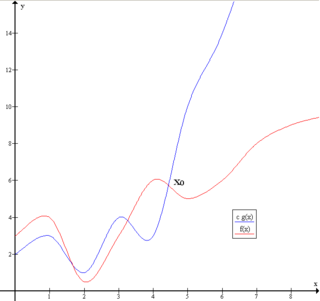
In mathematics, convolution is a mathematical operation on two functions that produces a third function that expresses how the shape of one is modified by the other. The term convolution refers to both the result function and to the process of computing it. It is defined as the integral of the product of the two functions after one is reflected about the y-axis and shifted. The choice of which function is reflected and shifted before the integral does not change the integral result. The integral is evaluated for all values of shift, producing the convolution function.

G, or g, is the seventh letter in the Latin alphabet, used in the modern English alphabet, the alphabets of other western European languages and others worldwide. Its name in English is gee, plural gees.

In physics, the kinetic energy of an object is the form of energy that it possesses due to its motion.

Big O notation is a mathematical notation that describes the limiting behavior of a function when the argument tends towards a particular value or infinity. Big O is a member of a family of notations invented by German mathematicians Paul Bachmann, Edmund Landau, and others, collectively called Bachmann–Landau notation or asymptotic notation. The letter O was chosen by Bachmann to stand for Ordnung, meaning the order of approximation.

In physics, engineering and mathematics, the Fourier transform (FT) is an integral transform that converts a function into a form that describes the frequencies present in the original function. The output of the transform is a complex-valued function of frequency. The term Fourier transform refers to both this complex-valued function and the mathematical operation. When a distinction needs to be made the Fourier transform is sometimes called the frequency domain representation of the original function. The Fourier transform is analogous to decomposing the sound of a musical chord into the intensities of its constituent pitches.

In thermodynamics, the Gibbs free energy is a thermodynamic potential that can be used to calculate the maximum amount of work, other than pressure-volume work, that may be performed by a thermodynamically closed system at constant temperature and pressure. It also provides a necessary condition for processes such as chemical reactions that may occur under these conditions. The Gibbs free energy is expressed as

The Glyphipterigidae are a family of small moths commonly known as sedge moths, as the larvae of many species feed on sedges and rushes. More than 500 species have been described in the family.
Ussara polyastra is a moth in the family Glyphipterigidae. It is known from South Africa.
Ussara semicoronis is a moth in the family Glyphipterigidae. It is known from Ethiopia.
Ussara ancobathra is a species of sedge moth in the genus Ussara. It was described by Edward Meyrick in 1932. It is found in Brazil.
Ussara ancyristis is a species of sedge moth in the genus Ussara. It was described by Edward Meyrick in 1920. It is found in Brazil.
Ussara arquata is a species of sedge moth in the genus Ussara. It was described by Edward Meyrick in 1926. It is found in Colombia.
Ussara chrysangela is a species of sedge moth in the genus Ussara. It was described by Edward Meyrick in 1922. It is found in Peru.
Ussara decoratella is a species of sedge moth in the genus Ussara. It was described by Francis Walker in 1864. It is found in Brazil.
Ussara eurythmiella is a species of sedge moth in the genus Ussara. It was described by August Busck in 1914. It is found in Panama.
Ussara hilarodes is a species of sedge moth in the genus Ussara. It was described by Edward Meyrick in 1909. It is found in Assam, India.
Ussara iochrysa is a species of sedge moth in the genus Ussara. It was described by Edward Meyrick in 1921. It is found on Java.
Ussara olyranta is a species of sedge moth in the genus Ussara. It was described by Edward Meyrick in 1931. It is found in Brazil.
Ussara phaeobathra is a species of sedge moth in the genus Ussara. It was described by Edward Meyrick in 1932. It is found in South America.
Ussara semmicornis is a species of sedge moth in the genus Ussara. It was described by Edward Meyrick in 1932. It is found in Ethiopia.







